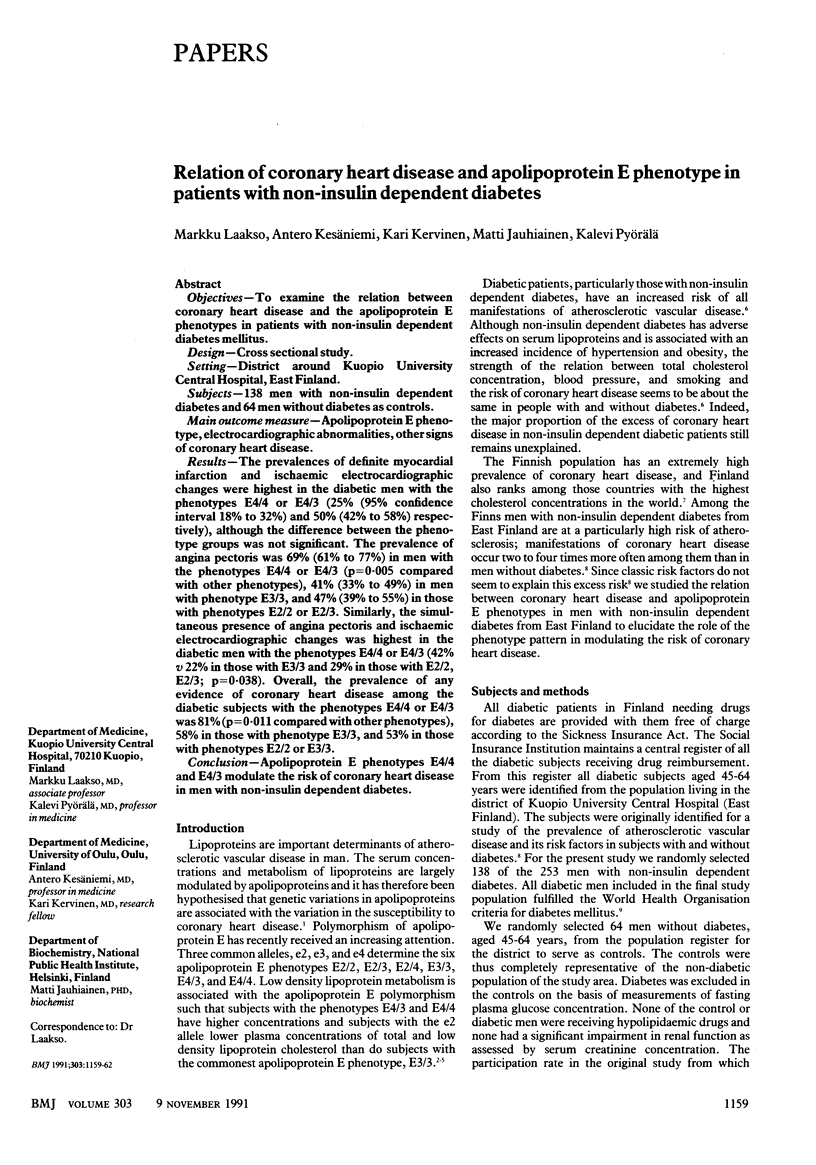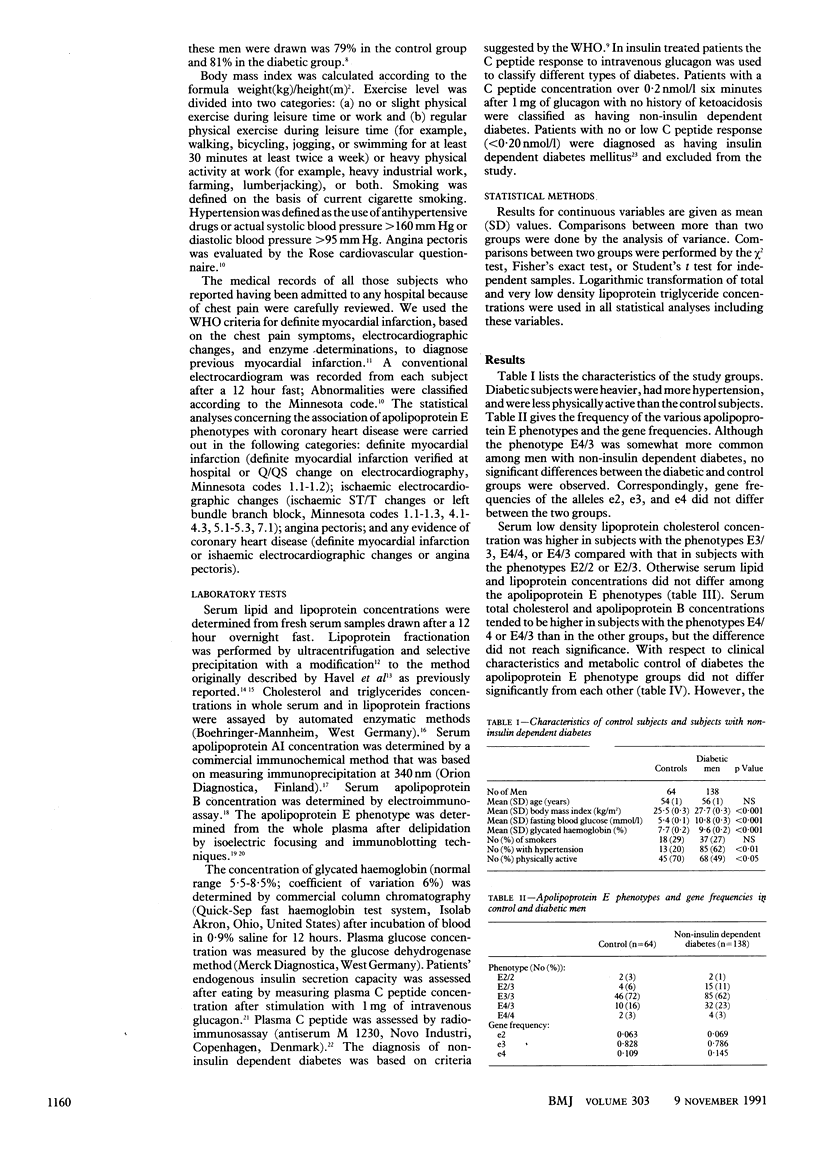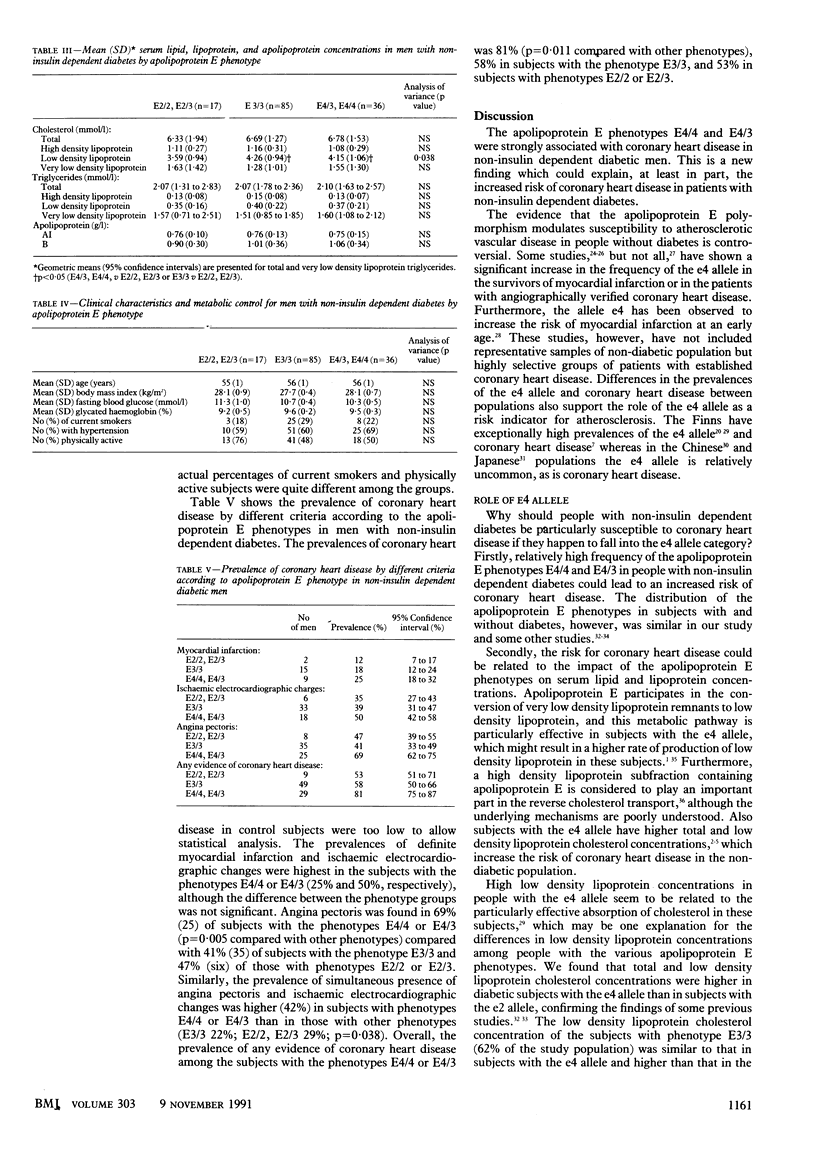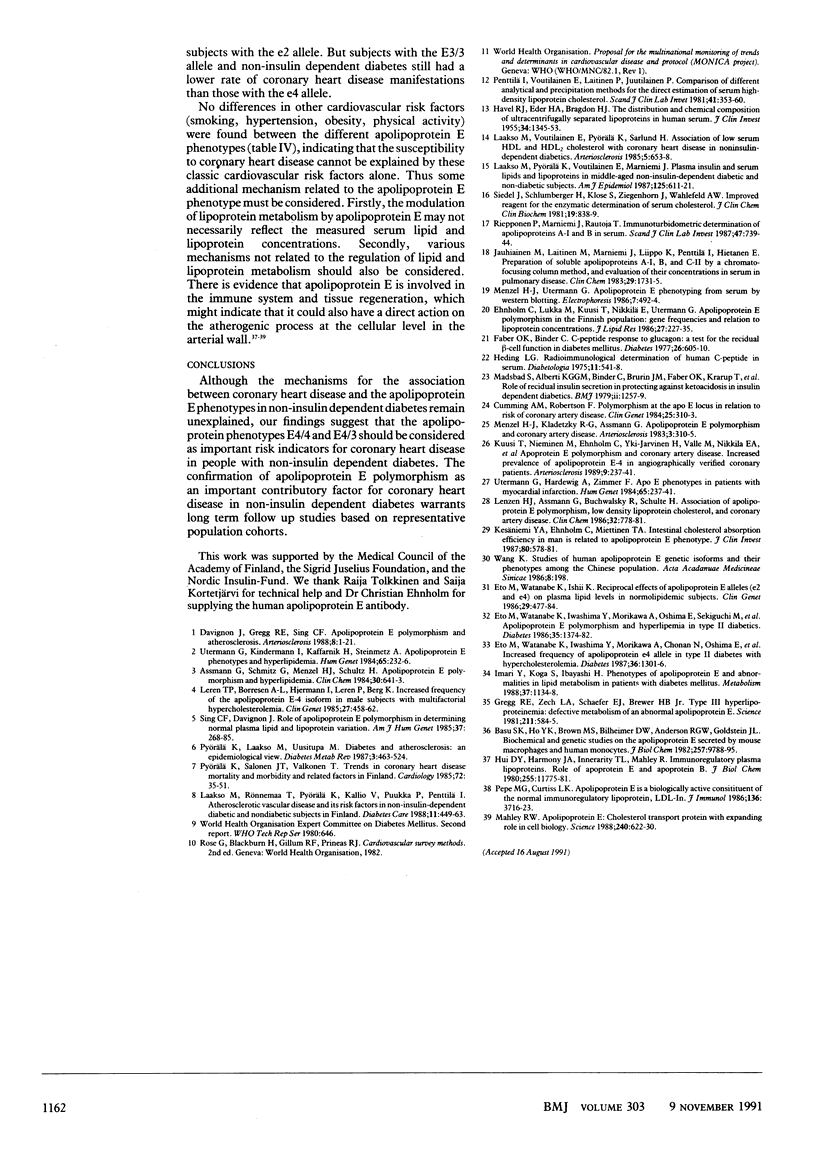Abstract
OBJECTIVES--To examine the relation between coronary heart disease and the apolipoprotein E phenotypes in patients with non-insulin dependent diabetes mellitus. DESIGN--Cross sectional study. SETTING--District around Kuopio University Central Hospital, East Finland. SUBJECTS--138 men with non-insulin dependent diabetes and 64 men without diabetes as controls. MAIN OUTCOME MEASURE--Apolipoprotein E phenotype, electrocardiographic abnormalities, other signs of coronary heart disease. RESULTS--The prevalences of definite myocardial infarction and ischaemic electrocardiographic changes were highest in the diabetic men with the phenotypes E4/4 or E4/3 (25% (95% confidence interval 18% to 32%) and 50% (42% to 58%) respectively), although the difference between the phenotype groups was not significant. The prevalence of angina pectoris was 69% (61% to 77%) in men with the phenotypes E4/4 or E4/3 (p = 0.005 compared with other phenotypes), 41% (33% to 49%) in men with phenotype E3/3, and 47% (39% to 55%) in those with phenotypes E2/2 or E2/3. Similarly, the simultaneous presence of angina pectoris and ischaemic electrocardiographic changes was highest in the diabetic men with the phenotypes E4/4 or E4/3 (42% v 22% in those with E3/3 and 29% in those with E2/2, E2/3; p = 0.038). Overall, the prevalence of any evidence of coronary heart disease among the diabetic subjects with the phenotypes E4/4 or E4/3 was 81% (p = 0.011 compared with other phenotypes), 58% in those with phenotype E3/3, and 53% in those with phenotypes E2/2 or E3/3. CONCLUSION--Apolipoprotein E phenotypes E4/4 and E4/3 modulate the risk of coronary heart disease in men with non-insulin dependent diabetes.
Full text
PDF



Selected References
These references are in PubMed. This may not be the complete list of references from this article.
- Assmann G., Schmitz G., Menzel H. J., Schulte H. Apolipoprotein E polymorphism and hyperlipidemia. Clin Chem. 1984 May;30(5):641–643. [PubMed] [Google Scholar]
- Basu S. K., Ho Y. K., Brown M. S., Bilheimer D. W., Anderson R. G., Goldstein J. L. Biochemical and genetic studies of the apoprotein E secreted by mouse macrophages and human monocytes. J Biol Chem. 1982 Aug 25;257(16):9788–9795. [PubMed] [Google Scholar]
- Cumming A. M., Robertson F. W. Polymorphism at the apoprotein-E locus in relation to risk of coronary disease. Clin Genet. 1984 Apr;25(4):310–313. doi: 10.1111/j.1399-0004.1984.tb01995.x. [DOI] [PubMed] [Google Scholar]
- Davignon J., Gregg R. E., Sing C. F. Apolipoprotein E polymorphism and atherosclerosis. Arteriosclerosis. 1988 Jan-Feb;8(1):1–21. doi: 10.1161/01.atv.8.1.1. [DOI] [PubMed] [Google Scholar]
- Ehnholm C., Lukka M., Kuusi T., Nikkilä E., Utermann G. Apolipoprotein E polymorphism in the Finnish population: gene frequencies and relation to lipoprotein concentrations. J Lipid Res. 1986 Mar;27(3):227–235. [PubMed] [Google Scholar]
- Eto M., Watanabe K., Ishii K. Reciprocal effects of apolipoprotein E alleles (epsilon 2 and epsilon 4) on plasma lipid levels in normolipidemic subjects. Clin Genet. 1986 Jun;29(6):477–484. doi: 10.1111/j.1399-0004.1986.tb00547.x. [DOI] [PubMed] [Google Scholar]
- Eto M., Watanabe K., Iwashima Y., Morikawa A., Chonan N., Oshima E., Sekiguchi M., Ishii K. Increased frequency of apolipoprotein epsilon 4 allele in type II diabetes with hypercholesterolemia. Diabetes. 1987 Nov;36(11):1301–1306. doi: 10.2337/diab.36.11.1301. [DOI] [PubMed] [Google Scholar]
- Eto M., Watanabe K., Iwashima Y., Morikawa A., Oshima E., Sekiguchi M., Ishii K. Apolipoprotein E polymorphism and hyperlipemia in type II diabetics. Diabetes. 1986 Dec;35(12):1374–1382. doi: 10.2337/diab.35.12.1374. [DOI] [PubMed] [Google Scholar]
- Faber O. K., Binder C. C-peptide response to glucagon. A test for the residual beta-cell function in diabetes mellitus. Diabetes. 1977 Jul;26(7):605–610. doi: 10.2337/diab.26.7.605. [DOI] [PubMed] [Google Scholar]
- Gregg R. E., Zech L. A., Schaefer E. J., Brewer H. B., Jr Type III hyperlipoproteinemia: defective metabolism of an abnormal apolipoprotein E. Science. 1981 Feb 6;211(4482):584–586. doi: 10.1126/science.7455696. [DOI] [PubMed] [Google Scholar]
- HAVEL R. J., EDER H. A., BRAGDON J. H. The distribution and chemical composition of ultracentrifugally separated lipoproteins in human serum. J Clin Invest. 1955 Sep;34(9):1345–1353. doi: 10.1172/JCI103182. [DOI] [PMC free article] [PubMed] [Google Scholar]
- Heding L. G. Radioimmunological determination of human C-peptide in serum. Diabetologia. 1975 Dec;11(6):541–548. doi: 10.1007/BF01222104. [DOI] [PubMed] [Google Scholar]
- Hui D. Y., Harmony J. A., Innerarity T. L., Mahley R. W. Immunoregulatory plasma lipoproteins. Role of apoprotein E and apoprotein B. J Biol Chem. 1980 Dec 25;255(24):11775–11781. [PubMed] [Google Scholar]
- Imari Y., Koga S., Ibayashi H. Phenotypes of apolipoprotein E and abnormalities in lipid metabolism in patients with non-insulin-dependent diabetes mellitus. Metabolism. 1988 Dec;37(12):1134–1138. doi: 10.1016/0026-0495(88)90189-8. [DOI] [PubMed] [Google Scholar]
- Jauhiainen M., Laitinen M., Marniemi J., Liippo K., Penttilä I., Hietanen E. Preparation of soluble apolipoproteins A-I, B, and C-II by a chromatofocusing column method, and evaluation of their concentrations in serum in pulmonary disease. Clin Chem. 1983 Oct;29(10):1731–1735. [PubMed] [Google Scholar]
- Kesäniemi Y. A., Ehnholm C., Miettinen T. A. Intestinal cholesterol absorption efficiency in man is related to apoprotein E phenotype. J Clin Invest. 1987 Aug;80(2):578–581. doi: 10.1172/JCI113107. [DOI] [PMC free article] [PubMed] [Google Scholar]
- Kuusi T., Nieminen M. S., Ehnholm C., Yki-Järvinen H., Valle M., Nikkilä E. A., Taskinen M. R. Apoprotein E polymorphism and coronary artery disease. Increased prevalence of apolipoprotein E-4 in angiographically verified coronary patients. Arteriosclerosis. 1989 Mar-Apr;9(2):237–241. doi: 10.1161/01.atv.9.2.237. [DOI] [PubMed] [Google Scholar]
- Laakso M., Pyörälä K., Voutilainen E., Marniemi J. Plasma insulin and serum lipids and lipoproteins in middle-aged non-insulin-dependent diabetic and non-diabetic subjects. Am J Epidemiol. 1987 Apr;125(4):611–621. doi: 10.1093/oxfordjournals.aje.a114574. [DOI] [PubMed] [Google Scholar]
- Laakso M., Rönnemaa T., Pyörälä K., Kallio V., Puukka P., Penttilä I. Atherosclerotic vascular disease and its risk factors in non-insulin-dependent diabetic and nondiabetic subjects in Finland. Diabetes Care. 1988 Jun;11(6):449–463. doi: 10.2337/diacare.11.6.449. [DOI] [PubMed] [Google Scholar]
- Laakso M., Voutilainen E., Pyörälä K., Sarlund H. Association of low HDL and HDL2 cholesterol with coronary heart disease in noninsulin-dependent diabetics. Arteriosclerosis. 1985 Nov-Dec;5(6):653–658. doi: 10.1161/01.atv.5.6.653. [DOI] [PubMed] [Google Scholar]
- Lenzen H. J., Assmann G., Buchwalsky R., Schulte H. Association of apolipoprotein E polymorphism, low-density lipoprotein cholesterol, and coronary artery disease. Clin Chem. 1986 May;32(5):778–781. [PubMed] [Google Scholar]
- Leren T. P., Børresen A. L., Berg K., Hjermann I., Leren P. Increased frequency of the apolipoprotein E-4 isoform in male subjects with multifactorial hypercholesterolemia. Clin Genet. 1985 May;27(5):458–462. doi: 10.1111/j.1399-0004.1985.tb00231.x. [DOI] [PubMed] [Google Scholar]
- Madsbad S., Alberti K. G., Binder C., Burrin J. M., Faber O. K., Krarup T., Regeur L. Role of residual insulin secretion in protecting against ketoacidosis in insulin-dependent diabetes. Br Med J. 1979 Nov 17;2(6200):1257–1259. doi: 10.1136/bmj.2.6200.1257. [DOI] [PMC free article] [PubMed] [Google Scholar]
- Mahley R. W. Apolipoprotein E: cholesterol transport protein with expanding role in cell biology. Science. 1988 Apr 29;240(4852):622–630. doi: 10.1126/science.3283935. [DOI] [PubMed] [Google Scholar]
- Menzel H. J., Kladetzky R. G., Assmann G. Apolipoprotein E polymorphism and coronary artery disease. Arteriosclerosis. 1983 Jul-Aug;3(4):310–315. doi: 10.1161/01.atv.3.4.310. [DOI] [PubMed] [Google Scholar]
- Penttilä I. M., Voutilainen E., Laitinen P., Juutilainen P. Comparison of different analytical and precipitation methods for direct estimation of serum high-density lipoprotein cholesterol. Scand J Clin Lab Invest. 1981 Jun;41(4):353–360. doi: 10.3109/00365518109092057. [DOI] [PubMed] [Google Scholar]
- Pepe M. G., Curtiss L. K. Apolipoprotein E is a biologically active constituent of the normal immunoregulatory lipoprotein, LDL-In. J Immunol. 1986 May 15;136(10):3716–3723. [PubMed] [Google Scholar]
- Pyörälä K., Laakso M., Uusitupa M. Diabetes and atherosclerosis: an epidemiologic view. Diabetes Metab Rev. 1987 Apr;3(2):463–524. doi: 10.1002/dmr.5610030206. [DOI] [PubMed] [Google Scholar]
- Pyörälä K., Salonen J. T., Valkonen T. Trends in coronary heart disease mortality and morbidity and related factors in Finland. Cardiology. 1985;72(1-2):35–51. doi: 10.1159/000173839. [DOI] [PubMed] [Google Scholar]
- Riepponen P., Marniemi J., Rautaoja T. Immunoturbidimetric determination of apolipoproteins A-1 and B in serum. Scand J Clin Lab Invest. 1987 Nov;47(7):739–744. [PubMed] [Google Scholar]
- Sing C. F., Davignon J. Role of the apolipoprotein E polymorphism in determining normal plasma lipid and lipoprotein variation. Am J Hum Genet. 1985 Mar;37(2):268–285. [PMC free article] [PubMed] [Google Scholar]
- Utermann G., Hardewig A., Zimmer F. Apolipoprotein E phenotypes in patients with myocardial infarction. Hum Genet. 1984;65(3):237–241. doi: 10.1007/BF00286509. [DOI] [PubMed] [Google Scholar]
- Utermann G., Kindermann I., Kaffarnik H., Steinmetz A. Apolipoprotein E phenotypes and hyperlipidemia. Hum Genet. 1984;65(3):232–236. doi: 10.1007/BF00286508. [DOI] [PubMed] [Google Scholar]


